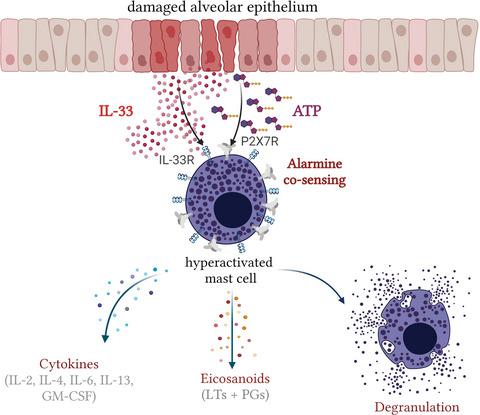当前位置:
X-MOL 学术
›
Immunology
›
论文详情
Our official English website, www.x-mol.net, welcomes your feedback! (Note: you will need to create a separate account there.)
ATP/IL-33-triggered hyperactivation of mast cells results in an amplified production of pro-inflammatory cytokines and eicosanoids
Immunology ( IF 6.4 ) Pub Date : 2021-06-17 , DOI: 10.1111/imm.13386 Paul M Jordan 1 , Nico Andreas 2 , Marco Groth 3 , Philine Wegner 2 , Franziska Weber 2 , Ute Jäger 2 , Claudia Küchler 2 , Oliver Werz 1 , Edgar Serfling 4 , Thomas Kamradt 2 , Anne Dudeck 5, 6 , Sebastian Drube 2
Immunology ( IF 6.4 ) Pub Date : 2021-06-17 , DOI: 10.1111/imm.13386 Paul M Jordan 1 , Nico Andreas 2 , Marco Groth 3 , Philine Wegner 2 , Franziska Weber 2 , Ute Jäger 2 , Claudia Küchler 2 , Oliver Werz 1 , Edgar Serfling 4 , Thomas Kamradt 2 , Anne Dudeck 5, 6 , Sebastian Drube 2
Affiliation

|
IL-33 and ATP are alarmins, which are released upon damage of cellular barriers or are actively secreted upon cell stress. Due to high-density expression of the IL-33 receptor T1/ST2 (IL-33R), and the ATP receptor P2X7, mast cells (MCs) are one of the first highly sensitive sentinels recognizing released IL-33 or ATP in damaged peripheral tissues. Whereas IL-33 induces the MyD88-dependent activation of the TAK1-IKK2-NF-κB signalling, ATP induces the Ca2+-dependent activation of NFAT. Thereby, each signal alone only induces a moderate production of pro-inflammatory cytokines and lipid mediators (LMs). However, MCs, which simultaneously sense (co-sensing) IL-33 and ATP, display an enhanced and prolonged activation of the TAK1-IKK2-NF-κB signalling pathway. This resulted in a massive production of pro-inflammatory cytokines such as IL-2, IL-4, IL-6 and GM-CSF as well as of arachidonic acid-derived cyclooxygenase (COX)-mediated pro-inflammatory prostaglandins (PGs) and thromboxanes (TXs), hallmarks of strong MC activation. Collectively, these data show that co-sensing of ATP and IL-33 results in hyperactivation of MCs, which resembles to MC activation induced by IgE-mediated crosslinking of the FcεRI. Therefore, the IL-33/IL-33R and/or the ATP/P2X7 signalling axis are attractive targets for therapeutical intervention of diseases associated with the loss of integrity of cellular barriers such as allergic and infectious respiratory reactions.
中文翻译:

ATP/IL-33 触发的肥大细胞过度活化导致促炎细胞因子和类二十烷酸的产生增加
IL-33 和 ATP 是警报素,它们在细胞屏障受损时释放或在细胞应激时主动分泌。由于 IL-33 受体 T1/ST2 (IL-33R) 和 ATP 受体 P2X7 的高密度表达,肥大细胞 (MC) 是最早识别受损外周细胞中释放的 IL-33 或 ATP 的高度敏感哨兵之一。组织。IL-33 诱导 TAK1-IKK2-NF-κB 信号的 MyD88 依赖性激活,而 ATP 诱导 Ca 2+-NFAT 的依赖性激活。因此,每个信号单独仅诱导促炎细胞因子和脂质介质 (LM) 的适度产生。然而,同时感知(共感知)IL-33 和 ATP 的 MC 显示出 TAK1-IKK2-NF-κB 信号通路的增强和延长激活。这导致大量产生促炎细胞因子,如 IL-2、IL-4、IL-6 和 GM-CSF 以及花生四烯酸衍生的环氧合酶 (COX) 介导的促炎前列腺素 (PGs) 和血栓烷 (TX),强 MC 激活的标志。总的来说,这些数据表明 ATP 和 IL-33 的共同感应导致 MC 的过度活化,这类似于由 IgE 介导的 FcεRI 交联诱导的 MC 活化。所以,
更新日期:2021-06-17
中文翻译:

ATP/IL-33 触发的肥大细胞过度活化导致促炎细胞因子和类二十烷酸的产生增加
IL-33 和 ATP 是警报素,它们在细胞屏障受损时释放或在细胞应激时主动分泌。由于 IL-33 受体 T1/ST2 (IL-33R) 和 ATP 受体 P2X7 的高密度表达,肥大细胞 (MC) 是最早识别受损外周细胞中释放的 IL-33 或 ATP 的高度敏感哨兵之一。组织。IL-33 诱导 TAK1-IKK2-NF-κB 信号的 MyD88 依赖性激活,而 ATP 诱导 Ca 2+-NFAT 的依赖性激活。因此,每个信号单独仅诱导促炎细胞因子和脂质介质 (LM) 的适度产生。然而,同时感知(共感知)IL-33 和 ATP 的 MC 显示出 TAK1-IKK2-NF-κB 信号通路的增强和延长激活。这导致大量产生促炎细胞因子,如 IL-2、IL-4、IL-6 和 GM-CSF 以及花生四烯酸衍生的环氧合酶 (COX) 介导的促炎前列腺素 (PGs) 和血栓烷 (TX),强 MC 激活的标志。总的来说,这些数据表明 ATP 和 IL-33 的共同感应导致 MC 的过度活化,这类似于由 IgE 介导的 FcεRI 交联诱导的 MC 活化。所以,



























 京公网安备 11010802027423号
京公网安备 11010802027423号